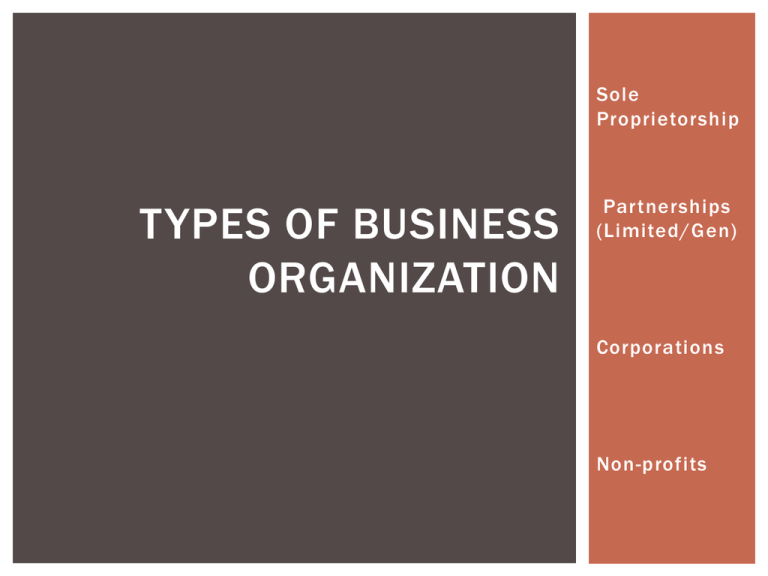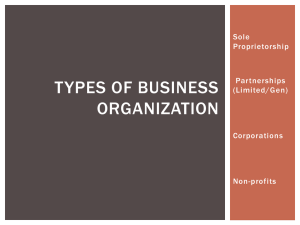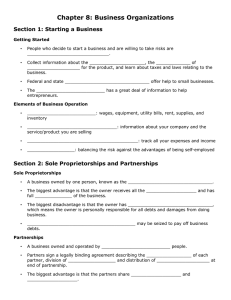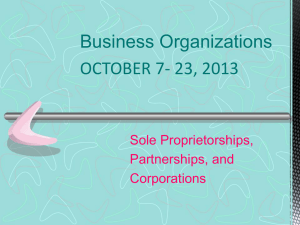Types of Business Organization - PBworks
advertisement

Sole Proprietorship TYPES OF BUSINESS ORGANIZATION Partnerships (Limited/Gen) Corporations Non-profits SOLE PROPRIETORSHIP- 72% OF BUSINESSES Advantages of sole proprietorships Economic Weakness of sole proprietorshi p : U n l i m i t e d L i a b i l i t y : yo u h ave t o t a l Ease of start up Ease of Management You keep all profits You do not have to pay any business taxes P s y c h ol og i c a l a d v a n t a g e s Ease of exit r e s p o ns i b i l i ty fo r a l l d e b t s a n d l i a b i l i t i e s o f t h e c o m p a ny Difficulty in raising financial capital Limited size and efficiency Limited managerial experience Limited Life STOP AND THINK If you started your own business what would it be? What are some of the 4 Factors of production you would need. 2 examples for each Land Labor Entrepreneur 9% OF BUSINESSES PARTNERSHIPS Two major types of partnerships: General Partnership: (most common type) all partners are responsible for management and the financial responsibilities of the partnership. Limited Partnership: at least one partner is not active in the day to day running of the business. They have limited liability. Articles of Partnership: contract between partners spelling out the rules of partnership. Dividing profit Dividing responsibility Admitting new partners Buying out partners PARTNERSHIPS Ad van t ages o f P a r t ne r s hips : D i sa d van t ag es o f P a r t n e r sh i ps E a se o f e st a b l ish men t U n l i m it ed l i a b ilit y E a se o f M a n a g em en t : e a c h L i m i te d p a r t n e r i s o n l y p a r t ner h a s d i fferent t hings t o re s p o ns ible fo r h i s i n i tial o ffer i nve s tm ent. H e h a s l i m ited No sp e c i a l b u si n e ss t a x e s l i ability. E a si e r t o r a i se f i n a n c ial c a p i t al L i m i te d L i f e L a r g e r t h a n so l e p r o p r i e to rsh ip C o n f l i ct b e t w een p a r t ners E a si e r t o a t t r a c t q u a l i fie d w o r ke r s WHAT FITS BEST WITH EACH BUSINESS??? TELL ME WHY!!! CORPORATIONS- 20% OF BUSINESS 74%PROFITS CORPORATION- SET UP Incorporate: to form a corporation. Charter: a document granted by the state giving a corporation the right to do business Stock: shares of ownership in the corporation Stockholders (shareholders): owners of stock. Reasons to own stock: Dividends: share of corporate profits paid to stockholders Speculation: buy in hope that price of stock will increase. STOCK CORPORATION- OWNERSHIP Common Stock is a basic share of owner ship in a corporation Have voting rights in the management of the company In reality they turn over voting rights to someone else with a proxy: giving someone else the right to vote your share of stock . Preferred Stock : Non voting shares of owner ship Guaranteed dividend Liquidation benefit: If corporation goes out of business they are ahead of common stockholders in getting back money. Board of Directors: duty to direct the corporations business by setting board policies and goals Elected by common stockholders Hires a professional management team to run day to day activities. (CEO, CFO….) CORPORATIONS Advantages of a corporation : Ease of raising financial capital (main advantage) Selling stock to investors Selling bonds: a written promise to repay a loan on a specific date Principal: the amount borrowed Interest: the price paid for the use of another’s money Borrowing money from banks. Ability to hire Limited liability Unlimited life Ease of transferring ownership: . Buying and selling stock is easy and is done millions of times a day Disadva nta g es of a corpora tion: Start up expenses are high. Stockholders (owners) have a limited Profits are taxed Corporations are subject to more government regulations than sole proprietors or partners DARE TO COMPARE Using the interwoven circles list the similarities and dif ferences between Sole Proprietorships, Partnerships, and Corporations NON-PROFITS: WE DON’T LIKE $$$ WE JUST WANT TO MAKE YOU WHO IS HERE TO HELP??? C o m m u n i t y a n d C i v i c o r g a n i z a t i on s Cooperatives- REI Consumer- Sam’s Club L a b o r , P r o f e s s i o n a l a n d B u s i n e s s O r g a n i z a t io n s L a b o r U n i o n s - o r g a n i z a t i o n o f w o r ke r s fo r m e d t o r e p r e s e nt i t s m e m b e r ’s i n t e re s t s i n va r y i n g e m p l o y me nt m a t t e r s. C o l l e c t i v e b a r g a i n i n g P r o f e s s i o n a l A s s o c i a t i o n s - a g r o u p o f p e o p l e i n a s p e c i a l i ze d f i e l d t h a t w o r k t o i m p r o ve t h e i r w o r k i ng c o n d i t i o ns. B u s i n e s s a s s o c i a t i on s C h a m b e r o f C o m m e r c e - p r o m o t e e c o no m i c g r o w t h o f t h e c o m m u ni ty B e t t e r B u s i n e s s B u r e a u - c o p s fo r b u s i ne s se s MERGERS AND ACQUISITIONS 5 Reasons to merge- Make money faster, Increase ef ficiency, Acquire new product lines, Catch up or eliminate rivals, Lose a company identity. Horizontal Merger- when two or more companies that product the same kind of product join forces. Vertical merger- when two or more firms that are at dif ferent steps of manufacturing process join together. Conglomerates- is a firm that has at least four businesses, each making unrelated products. BE A THINKER NOT A STINKER With a neighbor develop 2 examples of each type of merger Vertical Horizontal Conglomerate Why would companies ever want to merge???? 1 2 3 4 5 SUMMARY With a partner: Use two real organizations and design the following: A vertical merger A horizontal merger Conglomerate











